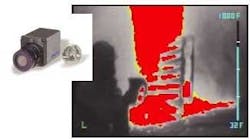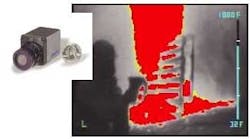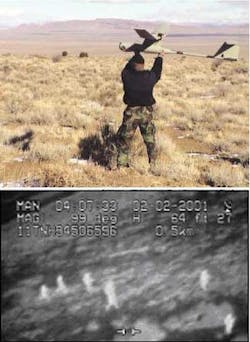Shrinking IR cameras enable new applications
Novel technologies are leading to a new breed of miniature IR cameras. Lightweight and portable, these imagers may eventually make it possible for all of us to "see in the dark."
Recent advances in miniaturization of IR imaging technology have led to a burgeoning market for mini- and micro-thermal-imaging sensors. Infrared sensors have broken through size, weight, power consumption, and cost barriers to become an enabling technology for a host of thermal-IR imaging applications that were previously difficult or impossible to implement, particularly those involving battery operation.
Miniature thermal-IR cameras see in the long-wave infrared region of the spectrum, between 7 and 14 µm, and can detect warm objects in total darkness. The smallest thermal-imaging cameras to date fit in the palm of a hand, weigh less than 5 oz (depending on the lens), and consume less than 1.5 W of electrical power under typical operating temperatures. This makes them very similar in form to the compact visible-light CMOS cameras currently used for security applications everywhere. Like silicon CMOS cameras, miniature thermal-imaging cameras produce standardized analog video output that can be transmitted to a range of display and recording devices.
Several new technologies are used to achieve these specifications in a miniature IR camera. The IR sensor itself is small, with a relatively low number of pixels, typically 160 × 128 pixels. Although this makes for a somewhat pixilated image, various smoothing filters applied to the digital image data after resampling up to analog video resolutions result in a remarkably clear analog video image. The image looks similar to the images produced by IR cameras with larger sensor arrays.
An IR camera requires a lot of electronics and computing horsepower. Reducing the number of connectors inside the camera lowers cost and significantly increases reliability. A single circuit board fabricated with specialized flex board technology folds up like an accordion inside the camera package, and the component count is reduced significantly by the use of high-performance miniature focal-plane arrays (FPAs) to process the image data as it comes out of the sensor array, further reducing space requirements.
In terms of power consumption, the thermoelectric cooler (TEC) is one of the biggest consumers in uncooled thermal-imaging cameras. The TEC stabilizes the sensor temperature, which has traditionally been a requirement of uncooled cameras because their detectors respond not only to heating from external radiation sources imaged onto them by the camera lens, but also to radiation from their surroundings within the camera body itself. We have developed a sensor based on vanadium oxide microbolometer technology that does not require temperature stabilization, thereby eliminating the need for a TEC. This advance was made possible by proprietary readout circuitry in the sensor array and novel nonuniformity correction algorithms.
FIGURE 1. The Omega IR camera incorporates several novel technologies that allow it to be miniaturized (inset). One version of the camera has been integrated into a hand-held enclosure for firefighters, which was used to produce an image of a fire and firefighter in a burning room using the SmartScene conversion algorithm and coarse radiometry (above). The yellow pixels correspond to temperatures above 842°F and the red pixels to temperatures above 887°F. The scene temperature measured by the spot meter denoted by the green dot in the center of the image is read out on the bar indicator at right. This bar indicator changes color to indicate high- or low-gain mode. The "L" indicator tells the user that the imager is in low sensitivity or "firefighting" mode, which extends its dynamic range and is particularly useful in the widely varying temperatures of the fire service.
One camera incorporating these technologies can produce an image in less than one second after power-up (see Fig. 1 inset). In firefighting and military applications, in which cameras are turned on and off to conserve battery power, delays in producing an image can be dangerous. Power consumption typically increases as the difference between the camera-case temperature and the FPA temperature grows (a situation often encountered in firefighting when ambient air temperatures can be several hundred degrees Celsius) and the TEC-less cameras operate with overall reduced power consumption—a crucial feature in battery-powered applications.
Another advantage to TEC-less operation is reduced heat buildup within the camera package. In firefighting applications the sensor is enclosed in insulation and self-heats, so reducing power consumption is especially important. With the new FPA and nonuniformity correction algorithms, the scene dynamic range is extended considerably compared to TEC-stabilized cameras because of the reduction of the effects of stray radiation from the optics and FPA enclosure.
Firefighting applications
Firefighters have used thermal-imaging cameras for about 10 years to see through smoke and to detect hot spots in floors, walls, and ceilings. Smoke has a large component of micron-sized carbon soot particles, making it very absorbing at visible-light wavelengths. However, when the particle size is significantly smaller than the wavelength of light used by a sensor, the scattering is greatly reduced, making it possible to see through the smoke.
The ability to detect temperature differences between objects is vitally important to firefighters, who must open doors that lead to fires and also must identify the seat and extension of a fire quickly and reliably. Thermal-imaging cameras have proven to be an excellent tool when used by experienced and well-trained firefighters, but early thermal-imaging technology was too heavy and awkward to use, lacked sufficient dynamic range to be useful in some situations, and was too expensive for many local fire departments. Improvements in size, weight, and cost have, therefore, been of paramount importance to the firefighting industry. One affordable solution has come from Mine Safety Appliances Company (MSA; Pittsburgh, PA), which has integrated a version of the Omega camera into a hand-held enclosure.
The fire service also requires a camera with a very wide scene dynamic range because when a camera is pointed in the direction of a very hot fire it must still produce a usable image of the colder surroundings or personnel without saturation. We have developed a 14-bit scene dynamic range with a nonlinear histogram AGC (automatic gain control) conversion algorithm named SmartScene to map the 14-bit range from the sensor to an 8-bit analog video display. The camera also has two gain states that are automatically selected according to the percentage of pixels in the image that go above or below a threshold value. This allows the camera to be used in both extremes of environments that firefighters regularly encounter, such as a dark, wet basement and a burning room (see Fig. 1). The battery is contained in the handle of the fire-service camera housing to insulate it from intense heat.
Unmanned aerial vehicles
Unmanned aerial vehicles (UAVs) are rapidly becoming more common in military operations, especially miniature UAVs, a category of aircraft small enough to be transported, launched, operated, and retrieved by a crew of one or two. These mini-UAVs are well suited for flying at low altitudes and for flying above building level in urban terrain to scout ahead of troops for potential ambushes or obstacles. The planes are radio-controlled and can be equipped with visible or IR video cameras downlinked to a ground station. The thermal-imaging capability enables the aircraft to fly in total darkness and detect targets through smoke—a capability that has been designed into several recently deployed UAVs, including AeroVironment's (Simi Valley, CA) Pointer UAV.
The Pointer can be carried in a backpack and is a hand-launched, lightweight aircraft powered by batteries, so minimizing weight, size, and power consumption of any on-board instrument is important. A tiny low-power-consumption thermal camera is typically mounted underneath the nose of the plane, pointing forward and angled down at 25° for forward reconnaissance and navigation (see Fig. 2). A second camera can be mounted in a side-looking configuration for observation of a fixed point while the aircraft flies in a loitering pattern. The same nonlinear histogram AGC algorithm used in firefighting is also used in the Omega UAV cameras to avoid the problem of a hot object in a reconnaissance scene "blowing out" the image or making the rest of the scene appear black.
The next killer app?
Thermal imaging will soon be as ubiquitous as technologies like radar and the global positioning system, both of which also originated in military laboratories and have successfully transferred into the commercial sector. In the post-Sept. 11 world, there has been a marked increase in interest in thermal imaging for all kinds of homeland-security applications, from long-range surveillance at border crossings and truck and shipping-container inspection to the monitoring of high-security installations such as nuclear power stations, airports, and dams.
In fact, IR imaging is so useful that it is probably just a matter of time before every policeman, firefighter, soldier, rescue worker, and security guard will have a personal IR camera in a compact, battery-powered package. The trend toward miniaturization of thermal cameras will result in emerging applications that enhance safety in everyday life. From skin-temperature monitoring systems—used at airports this year with the advent of SARS—to future penlight-sized IR cameras for scanning parking lots after dark, miniature thermal-imaging cameras are the next "killer app" of imaging technology.
AUSTIN RICHARDS is a research scientist at Indigo Systems, 70 Castilian Dr., Goleta, CA 93117; e-mail: [email protected].


